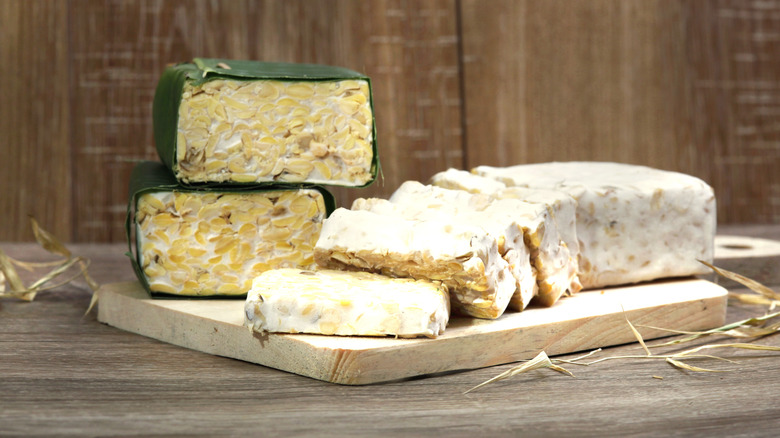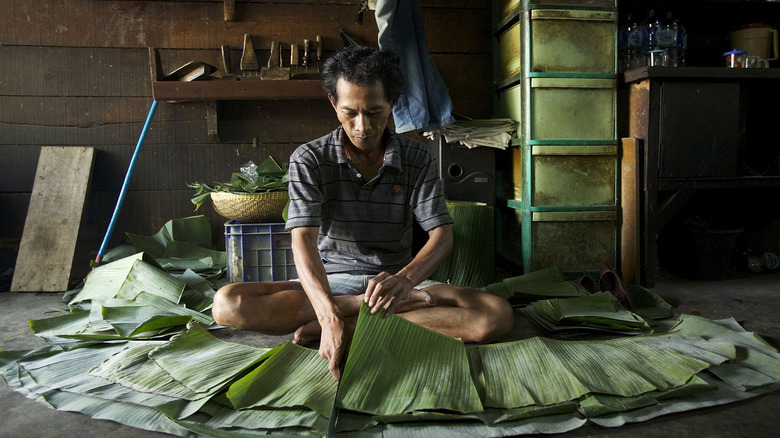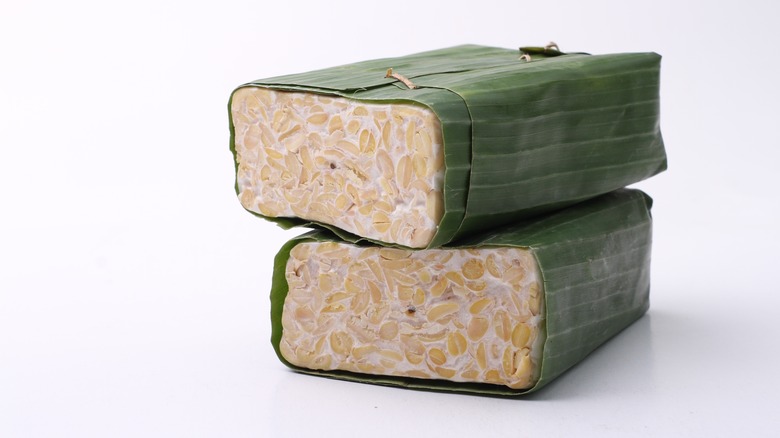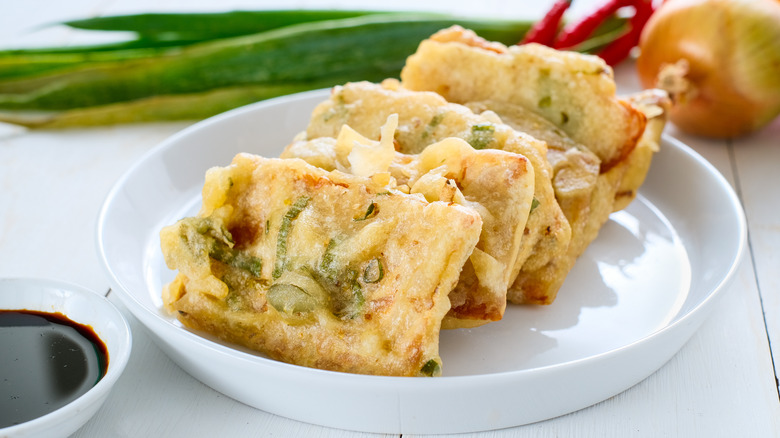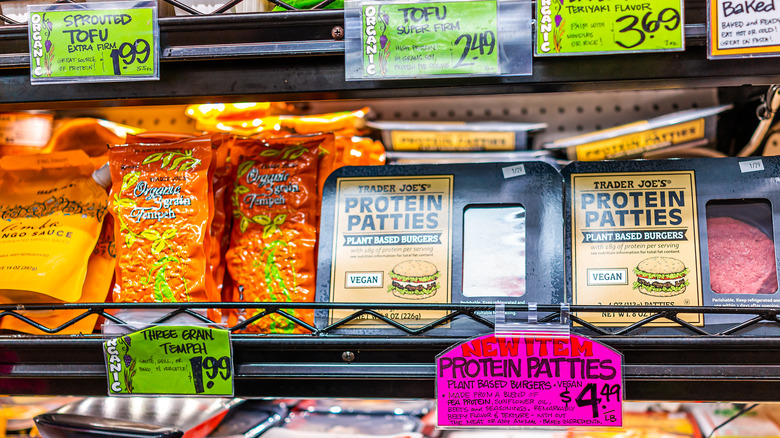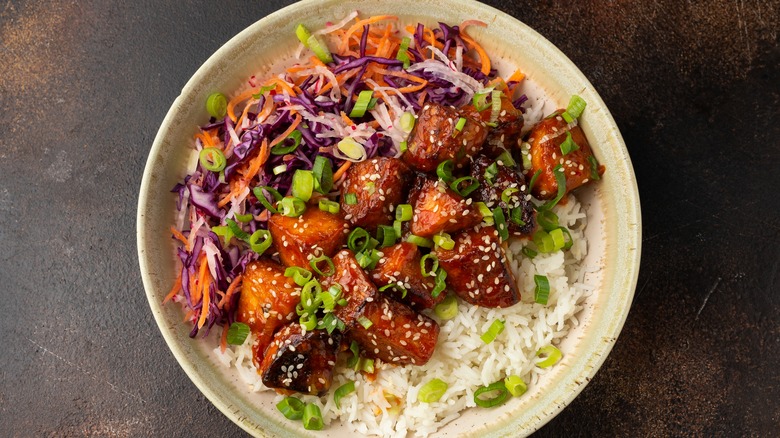The Fermented Soybean Ingredient That's A Staple In Indonesian Cuisine
Well-known since the 1980s (per Tofu Bud), most of the Western Hemisphere has been put on to tofu by now. Its Indonesian relative, tempeh, however, remains relatively unfamiliar — that is, unless you're plant-based, in which case you've most likely heard of eating it as a vegan bacon substitute. Spelled "tempe" in Indonesian and pronounced "tem-pay," the fermented soybean cakes date back 400 years to the island of Java (via Soy Info Center). There, Tempe Movement claims that tempeh is used widely as a part of the everyday diet, from baby food to snacks and even desserts.
In a country where meat is largely inaccessible, primarily due to the expensiveness of it, tempeh serves as an affordable and nutritious protein source for many Indonesians — especially those with limited incomes (via Serious Eats). While it may have once been characterized as a low-class food, a 2021 study published in Science Direct found that the negative attitudes around tempeh have changed with time. Now, not only is tempeh consumed by people from all socioeconomic classes, but it's also considered a point of pride for many Indonesian people.
While it may have only recently achieved modern "superfood" status in the US, Indonesian tempeh producers have had their own motivations that have carried the centuries-long tempeh movement forward. According to Bon Appétit, for many, the process of making tempeh is a way to carry on traditions, honor their Indonesian culture, and share it with the world. Now that's super.
How is tempeh made?
In Indonesia, making tempeh is a tradition — one that's been carried on through centuries with time and care. As Rustono, a tempeh producer from Java, Indonesia, told Good News From Indonesia, "The mold in tempeh breathes and grows, so Indonesians who make it take care of it like their children." After rinsing the soybeans in water and boiling them, they are soaked overnight, cut in half, and hulled to remove their outer coverings (via Bon Appétit). Then, they're mixed with a fungus called Rhizopus oligosporus – which grows on the leaves of Javanese hibiscus and teak trees — a starter fungus, or rice yeast, to ferment.
Traditionally, the mixture is wrapped in banana leaves or plastic bags for one to two days — however long it takes for the white mushroom mycelium to bond with the soybeans and form a compact cake. Not only does the fermentation process give tempeh its multi-dimensional flavor, but also its fibrous texture. The resulting product looks similar to a block of tofu but denser and with a visible network of split soybeans and white fibers. In Indonesia, the tempeh is sold fresh in morning markets just like that, banana leaf and all. The tempeh you'll find in the store, however, is typically frozen prior to being packaged and shipped for ultimate freshness.
Pasteurized vs. fresh
According to Bon Appétit, there are two different types of tempeh: fresh and pasteurized. If you're not familiar with pasteurization, Britannica defines it as a method of using heat to kill off pathogens and sterilize food. When it comes to tempeh, pasteurization is used to stop the fermentation process and prevent spoilage. While it does extend the shelf-life of the product, it does have some drawbacks — the most important one being the flavor. Pasteurized tempeh tends to have a more subtle and slightly more bitter taste than fresh tempeh.
Unfortunately, if you don't live in Indonesia or have a fresh tempeh producer in your area, pasteurized tempeh may be the only kind you can find. You'll know it by its slightly tan color, as fresh tempeh is white, with a creamier, meatier texture and bright umami flavor similar to mushrooms. Even though pasteurized tempeh may be easier to get your hands on, it's definitely worth splurging on the fresh stuff if it's available to you. The only downside is that its best-by date only exceeds about 3-5 days.
Cooking with tempeh
In the plant based-community, tempeh is added to everything, from salads to noodles and sandwiches to stews, as a source of vegan protein (via Bon Appétit). However, tempeh is much more than plant-based bacon and burgers — and nothing is more exemplary of that than Indonesian cuisine: In tumis tempeh, tempeh is sliced, stir-fried, and mixed with tamarind sweet and sour sauce (via Serious Eats). In tempe bacem, it is braised with palm sugar, sweet soy sauce, and spices before getting deep fried. In sayur lodeh, tempeh is simmered until soft a mixed with veggies, coconut milk, and golden turmeric paste (per Bon Appetit). These are just some of the infinite ways that tempeh is prepared and enjoyed.
Steamed, grilled, battered, deep-fried, pan-fried, or simmered, tempeh has more uses than is possible to list — however, each preparation method has its own advantages. Simmering, for example, allows the tempeh to act like a sponge that absorbs all of your marinades and sauces while adding its nutty flavor. But frying seems to be the favorite style for tempeh, at least in Indonesia, where it's almost always eaten deep-fried in snack dishes like tempe goreng and keripik tempeh, or "tempeh chips." According to Bon Appetit, deep frying actually amplifies the tempeh's umami flavor and meat-like texture. Rustono supports this stance, telling Good News From Indonesia that his favorite way to prepare tempeh is by deep frying it like fried chicken.
Where to buy tempeh
In Indonesia, you can find fresh tempeh sold in morning markets (via Good News From Indonesia) — and even some other varieties made using different legumes, nuts, and root vegetables like peanuts, cassava, or coconut (per Serious Eats). These, however, can be hard to come by in the United States. In fact, unless you have a fresh tempeh producer in your local area, it's not likely you'll be able to come by any fresh tempeh at the supermarket. Of course, the pasteurized style of tempeh tends to be the commonly found option at most stores. Usually, it will be found in the same section of the supermarket where you find tofu. Otherwise, it's most likely in the refrigerated vegan section, somewhere around the nut-based cheeses and vegan kimchi.
White, creamy, and brightly flavored, fresh tempeh is definitely worth getting if you can. Fortunately, Lara Lee from Bon Appétit shares a list of small, artisanal tempeh producers — and there are surprisingly a lot of them. From Portland, Oregon's Squirrel & Crow Tempeh, to Barry's Tempeh in New York, and from BeCultured Tempeh in Miami to Maui Tempeh in Hawaii, the Indonesian tradition of making tempeh has touched nearly every region of the United States. This means that no matter where you are in the country, you might be able to get your hands on some of the good stuff; you'll just need to do a little Google searching to find out what's available near you.
Nutrition info
Nutritionally, tempeh is unique because a 2021 study published by the Institute of Food Technology found it to be one of the richest and most potent sources of plant-based vitamin B12 in the world — with a protein content equivalent to the amount found in beef (via SF Gate). Vitamin B12 is a big deal for vegans and vegetarians, as it's a vitamin that isn't naturally produced by plants, according to The Vegan Society. It is, however, made by micro-organisms, which tempeh, being fermented, is rich in.
The fermentation that goes into creating tempeh doesn't only give it its impressive, plant-based B12 content, but it is also said to be beneficial to your gut microbiota, making it highly digestible and its nutrients more soluble (per Tempe Movement, Bon Appétit). It also cannot go without mentioning that not only does tempeh deliver the same protein content as beef, but it does so while utilizing 10x less energy and emitting a fifth of the CO2 into the atmosphere, all at a third of the price.
Without any of the saturated fat or cholesterol that's found in beef (via Tempe Movement), not only is tempeh a nutritional choice that is both delicious and sustainable, but it's an affordable and accessible one at that. With tempeh, everyone can make healthy choices.
